Choosing the wrong lights for damp hotel areas can lead to failures and safety risks. Avoid costly mistakes by selecting lighting designed to withstand moisture and protect your guests.
IP44 rated LED downlights are ideal for providing general, ambient lighting in hotel guest rooms and specific zones within bathrooms. Their design protects against solid objects over 1mm and water splashes from any direction, ensuring safety, longevity, and reliable performance in humid environments.
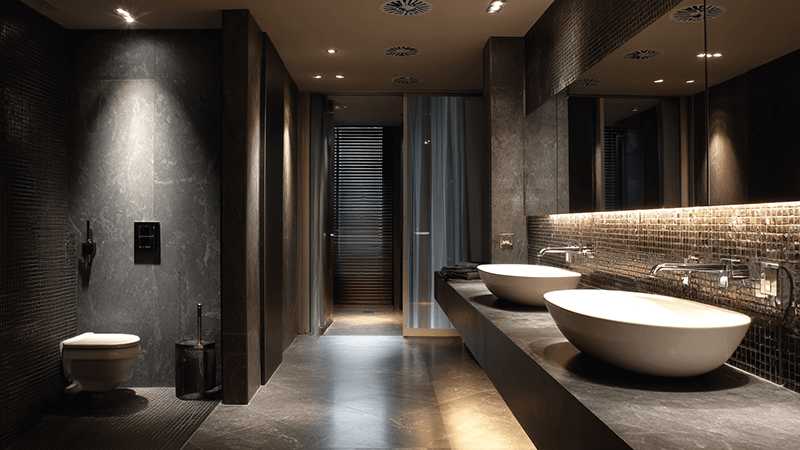
When I first started in this industry, I saw many projects where contractors cut corners on lighting in bathrooms. Within a year, those lights would fail due to moisture, leading to expensive callbacks and unhappy clients. This taught me a valuable lesson: matching the right tool for the job, or in this case, the right IP rating for the environment, is not just about following rules; it's about building a reputation for quality and reliability. This is especially true in the hospitality industry, where the guest experience is everything. Let's break down exactly how and where these essential lights should be used.
Can IP44 lights be used in a bathroom?
Navigating bathroom lighting regulations1 can be confusing. Using the wrong rating could compromise safety, but over-specifying feels like wasting money. Understanding bathroom zones2 is the key to clarity.
Yes, IP44 lights are specifically designed and perfectly safe for use in certain areas of a bathroom. They are ideal for Zone 2 and the outside zones (Zone 3), where protection against splashes, steam, and condensation is necessary.
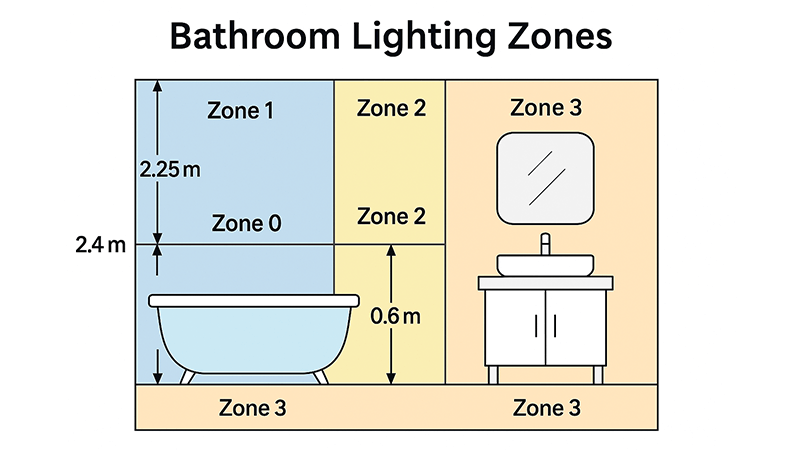
To understand where to use IP44 lights, we first need to talk about bathroom zones. Think of a bathroom as being divided into different areas based on their proximity to water. Electrical regulations in most countries use this zoning system to ensure safety.
Understanding Bathroom Zones
The zones dictate the minimum Ingress Protection (IP) rating3 a light fixture must have to be installed safely.
| Zone | Location | Minimum IP Rating | Common Use Case |
|---|---|---|---|
| Zone 0 | Inside the bath or shower tray itself. | IP67 | Submersible lighting, often for spas. |
| Zone 1 | Directly above the bath or shower, up to 2.25m high. | IP65 | Downlights directly over a shower. |
| Zone 2 | The area 0.6m outside the bath/shower and around the sink. | IP44 | Vanity lights, ceiling lights near the sink. |
| Outside Zones | Any area outside Zones 0, 1, and 2. | No specific IP rating required, but IP20 is a baseline. | General room lighting away from water. |
As you can see, IP44 is the standard for Zone 24. In a typical hotel bathroom, this is a large area. It includes the space around the washbasin and the general ceiling area outside the immediate shower enclosure5. I remember working on a project for a hotel chain in the UAE. The purchasing manager, much like you, was focused on durability and cost-effectiveness. We specified IP44 downlights for general illumination in their hundreds of bathrooms. This provided more than enough protection from steam and splashes from the sink, without the unnecessary cost of using IP656 fixtures everywhere. It’s about being smart and precise with your specifications.
What IP rating for downlights in bathroom?
Trying to pick just one IP rating for an entire bathroom is a common mistake. This approach can either be unsafe by under-protecting or wasteful by over-protecting certain areas.
The correct IP rating for a bathroom downlight depends entirely on its location. Use IP65 for downlights inside a shower enclosure (Zone 1) and IP44 for downlights in areas susceptible to splashes, like over a vanity (Zone 2).
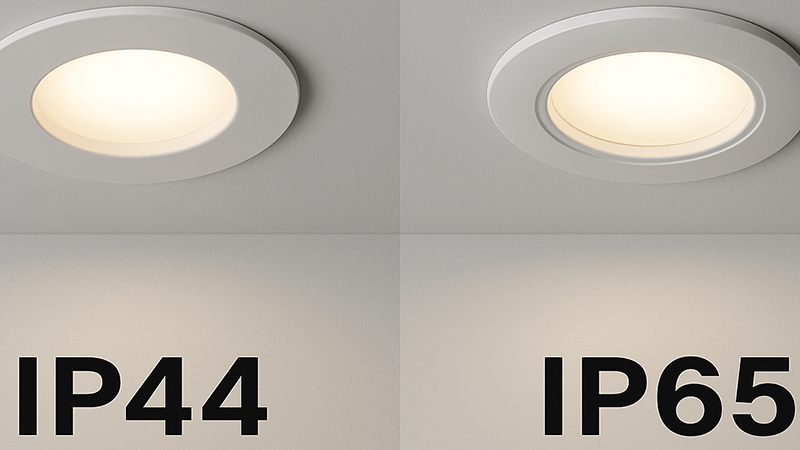
Choosing the right IP rating is a balancing act between safety, compliance, and budget. Let's dive deeper into the specific ratings you’ll encounter for bathroom lighting. An IP rating has two digits. The first tells you its protection against solids (like dust), and the second tells you its protection against liquids (water).
A Closer Look at IP Ratings
Here’s a simple breakdown of the ratings relevant to bathrooms:
- IP20: This is the standard for most indoor lights. It protects against objects larger than 12.5mm (like a finger) but offers zero protection against water. You can use these in a bathroom, but only far away from any water source (Outside Zones).
- IP44: The first '4' means it's protected against solid objects over 1mm. The second '4' means it's protected against water splashes from any direction. This makes it the perfect workhorse for most of the bathroom ceiling and wall areas.
- IP65: The '6' means it's completely dust-tight. The '5' means it's protected against jets of water from any direction. This is why it's the minimum requirement for the area directly above a shower (Zone 1).
As a manufacturer, the difference between an IP44 and an IP65 downlight is significant. An IP65 fixture requires specialized gaskets, sealed lenses, and more robust construction to prevent high-pressure water from getting inside. This adds to the material and labor cost. For a large hotel project, specifying IP65 everywhere would unnecessarily inflate the budget. A smart purchasing manager recognizes that placing IP44 fixtures in Zone 2 and reserving the more expensive IP65 models for Zone 1 is the most efficient and responsible approach. It meets all safety standards while maximizing the value of the investment.
What is IP44 commonly used for?
Many people think IP44 is just for bathrooms. This limits its potential, making you miss out on a versatile solution for many other challenging environments where moisture is a problem.
IP44 is widely used in any indoor or covered outdoor area where moisture, condensation, or water splashes are a concern. Common applications include kitchens, laundry rooms, basements, covered porches, and high-humidity commercial spaces7 like public restrooms8.
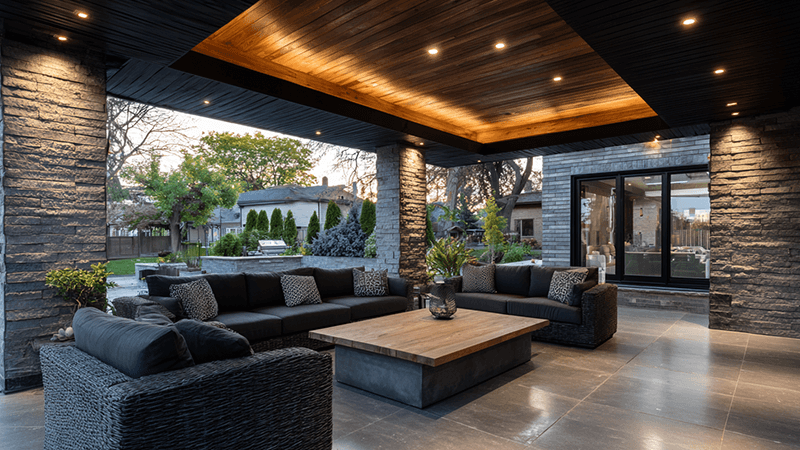
The protection offered by the IP44 rating makes it one of the most versatile ratings for LED lighting. Its ability to resist splashes and moisture makes it a reliable choice far beyond the bathroom. I've supplied IP44-rated products for a huge range of projects where humidity and condensation were the main enemies.
In High-Humidity Climates and Spaces
In tropical climates like Southeast Asia or parts of the Middle East, high ambient humidity can be relentless. I consulted on a resort project where standard indoor downlights in covered walkways were failing in less than a year, not from rain, but from the constant, thick, humid air. We replaced them with our IP44 downlights. The sealed design prevented the moist air from penetrating the housing and corroding the electronics. That was five years ago, and those lights are still performing perfectly. The same principle applies to basements, which are often prone to condensation due to temperature differences between the cool underground walls and the warmer indoor air.
In Commercial and Public Environments
The applications extend into demanding commercial spaces as well.
- Hotel Hospitality: Beyond guest bathrooms, think about hotel utility areas9, kitchens, and laundry rooms where steam is common.
- Public Restrooms: Airport and mall washrooms see heavy traffic and frequent cleaning, often involving water being sprayed on surfaces. IP44 lighting is robust enough to handle this environment day in and day out.
- Covered Outdoor Areas: Think of restaurant patios, hotel entrance canopies, or apartment balconies. While not exposed to direct rain, these areas are subject to mist, fog, and condensation. IP44 provides the necessary protection to ensure a long and reliable service life.
Essentially, anywhere you need a durable light that won't fail at the first sign of moisture, IP44 is an excellent and cost-effective specification.
Can you put an LED downlight above a shower?
You want bright, functional light directly in the shower cubicle. However, the obvious combination of water and electricity makes you worry about safety, and rightly so.
Yes, you can and should put an LED downlight10 above a shower to improve visibility and safety. To do so safely, you must use a fixture with a minimum rating of IP65 to protect it from direct water jets.
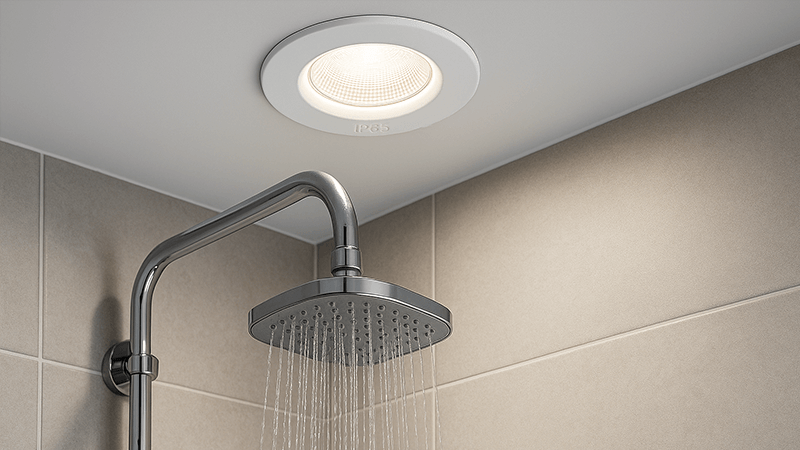
Placing a light directly inside a shower enclosure (Zone 1) transforms the space. It feels more open, cleaner, and more luxurious—a detail that guests in high-end hotels notice. However, this is an area where there is absolutely no room for compromise on safety or product specification.
An IP44-rated downlight is not sufficient for this location. While it can handle splashes, it is not designed to withstand the direct, pressurized jets of water from a modern showerhead. Water could force its way past the seals, creating a serious electrical hazard and causing the light to fail prematurely.
This is where the IP65 rating becomes mandatory. The '6' for solid protection ensures it's completely sealed against dust and steam particles, while the '5' for liquid protection guarantees it can handle water jets from any angle. When my team designs an IP65 downlight, we subject it to rigorous testing. We spray it with high-pressure water nozzles in a testing chamber to simulate years of daily showers. It's only after it passes these tests that we can confidently say it's safe for Zone 1.
For purchasing managers like Shaz, specifying IP65 for all in-shower lighting isn't just about following regulations—it's about ensuring guest safety, protecting the hotel's reputation, and investing in a product that will last. It's a critical detail that demonstrates a commitment to quality throughout the entire project.
Conclusion
IP44 is a versatile rating for damp areas like bathrooms and kitchens. For direct water exposure, such as inside a shower, always insist on the superior protection of IP65.
Stay informed about essential lighting regulations to ensure compliance and safety. ↩
Understanding bathroom zones is crucial for safe and effective lighting installation. ↩
Discover the importance of IP ratings in ensuring safety and compliance in lighting. ↩
Gain insights into Zone 2 regulations to ensure safe lighting installations in bathrooms. ↩
Understand the safety requirements for lighting in shower enclosures to prevent hazards. ↩
Find out why IP65 is essential for lighting fixtures in high-moisture areas like showers. ↩
Understand the unique lighting needs of commercial spaces to enhance functionality and safety. ↩
Discover the ideal lighting solutions for public restrooms to ensure durability and safety. ↩
Learn about the best lighting options for utility areas in hotels to ensure safety and efficiency. ↩
Explore the benefits of LED downlights for energy efficiency and longevity in hotel settings. ↩

